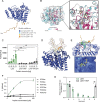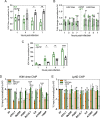Legionella para-effectors target chromatin and promote bacterial replication
- PMID: 37059817
- PMCID: PMC10104843
- DOI: 10.1038/s41467-023-37885-z
Legionella para-effectors target chromatin and promote bacterial replication
Abstract
Legionella pneumophila replicates intracellularly by secreting effectors via a type IV secretion system. One of these effectors is a eukaryotic methyltransferase (RomA) that methylates K14 of histone H3 (H3K14me3) to counteract host immune responses. However, it is not known how L. pneumophila infection catalyses H3K14 methylation as this residue is usually acetylated. Here we show that L. pneumophila secretes a eukaryotic-like histone deacetylase (LphD) that specifically targets H3K14ac and works in synergy with RomA. Both effectors target host chromatin and bind the HBO1 histone acetyltransferase complex that acetylates H3K14. Full activity of RomA is dependent on the presence of LphD as H3K14 methylation levels are significantly decreased in a ∆lphD mutant. The dependency of these two chromatin-modifying effectors on each other is further substantiated by mutational and virulence assays revealing that the presence of only one of these two effectors impairs intracellular replication, while a double knockout (∆lphD∆romA) can restore intracellular replication. Uniquely, we present evidence for "para-effectors", an effector pair, that actively and coordinately modify host histones to hijack the host response. The identification of epigenetic marks modulated by pathogens has the potential to lead to the development of innovative therapeutic strategies to counteract bacterial infection and strengthening host defences.
© 2023. The Author(s).
Conflict of interest statement
The authors declare no competing interests.
Figures






Similar articles
-
The SET and ankyrin domains of the secreted Legionella pneumophila histone methyltransferase work together to modify host chromatin.mBio. 2023 Oct 31;14(5):e0165523. doi: 10.1128/mbio.01655-23. Epub 2023 Oct 5. mBio. 2023. PMID: 37795993 Free PMC article.
-
Legionella pneumophila effector RomA uniquely modifies host chromatin to repress gene expression and promote intracellular bacterial replication.Cell Host Microbe. 2013 Apr 17;13(4):395-405. doi: 10.1016/j.chom.2013.03.004. Cell Host Microbe. 2013. PMID: 23601102
-
Legionella pneumophila type IV effectors hijack the transcription and translation machinery of the host cell.Trends Cell Biol. 2014 Dec;24(12):771-8. doi: 10.1016/j.tcb.2014.06.002. Epub 2014 Jul 8. Trends Cell Biol. 2014. PMID: 25012125 Review.
-
An acetyltransferase effector conserved across Legionella species targets the eukaryotic eIF3 complex to modulate protein translation.mBio. 2024 Mar 13;15(3):e0322123. doi: 10.1128/mbio.03221-23. Epub 2024 Feb 9. mBio. 2024. PMID: 38335095 Free PMC article.
-
Divergence of Legionella Effectors Reversing Conventional and Unconventional Ubiquitination.Front Cell Infect Microbiol. 2020 Aug 21;10:448. doi: 10.3389/fcimb.2020.00448. eCollection 2020. Front Cell Infect Microbiol. 2020. PMID: 32974222 Free PMC article. Review.
Cited by
-
Legionella pneumophila modulates macrophage functions through epigenetic reprogramming via the C-type lectin receptor Mincle.iScience. 2024 Aug 8;27(9):110700. doi: 10.1016/j.isci.2024.110700. eCollection 2024 Sep 20. iScience. 2024. PMID: 39252966 Free PMC article.
-
Cross-family small GTPase ubiquitination by the intracellular pathogen Legionella pneumophila.Mol Biol Cell. 2024 Mar 1;35(3):ar27. doi: 10.1091/mbc.E23-06-0260. Epub 2023 Dec 20. Mol Biol Cell. 2024. PMID: 38117589 Free PMC article.
-
Nuclear warfare: pathogen manipulation of the nuclear pore complex and nuclear functions.mBio. 2025 Apr 9;16(4):e0194024. doi: 10.1128/mbio.01940-24. Epub 2025 Mar 20. mBio. 2025. PMID: 40111017 Free PMC article. Review.
-
Experimental Approaches to Visualize Effector Protein Translocation During Host-Pathogen Interactions.Bioessays. 2025 Apr;47(4):e202400188. doi: 10.1002/bies.202400188. Epub 2025 Mar 13. Bioessays. 2025. PMID: 40078034 Free PMC article. Review.
-
A comprehensive two-hybrid analysis to explore the Legionella pneumophila effector-effector interactome.mSystems. 2024 Dec 17;9(12):e0100424. doi: 10.1128/msystems.01004-24. Epub 2024 Nov 11. mSystems. 2024. PMID: 39526800 Free PMC article.
References
Publication types
MeSH terms
Substances
LinkOut - more resources
Full Text Sources
Medical
Molecular Biology Databases

